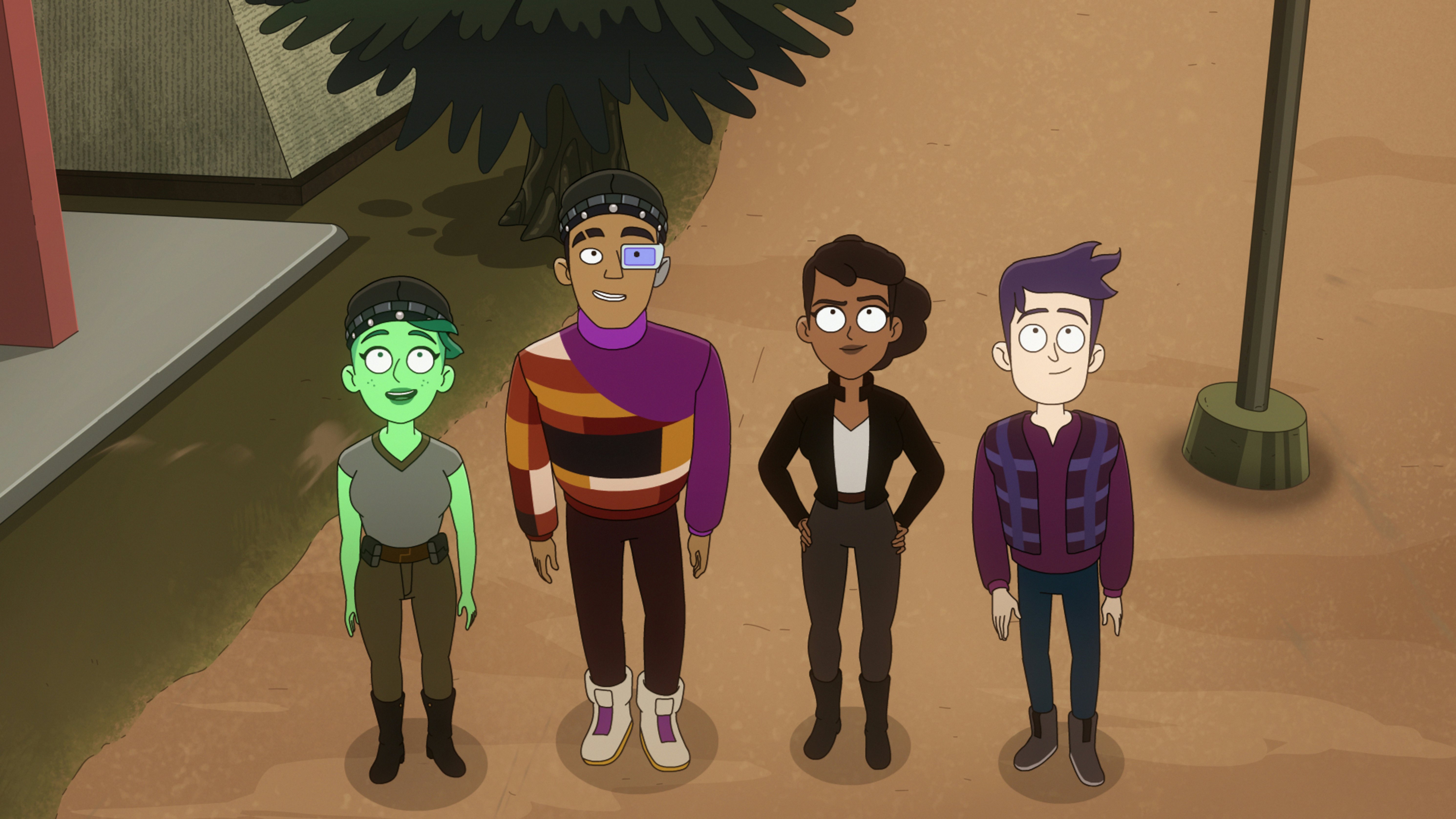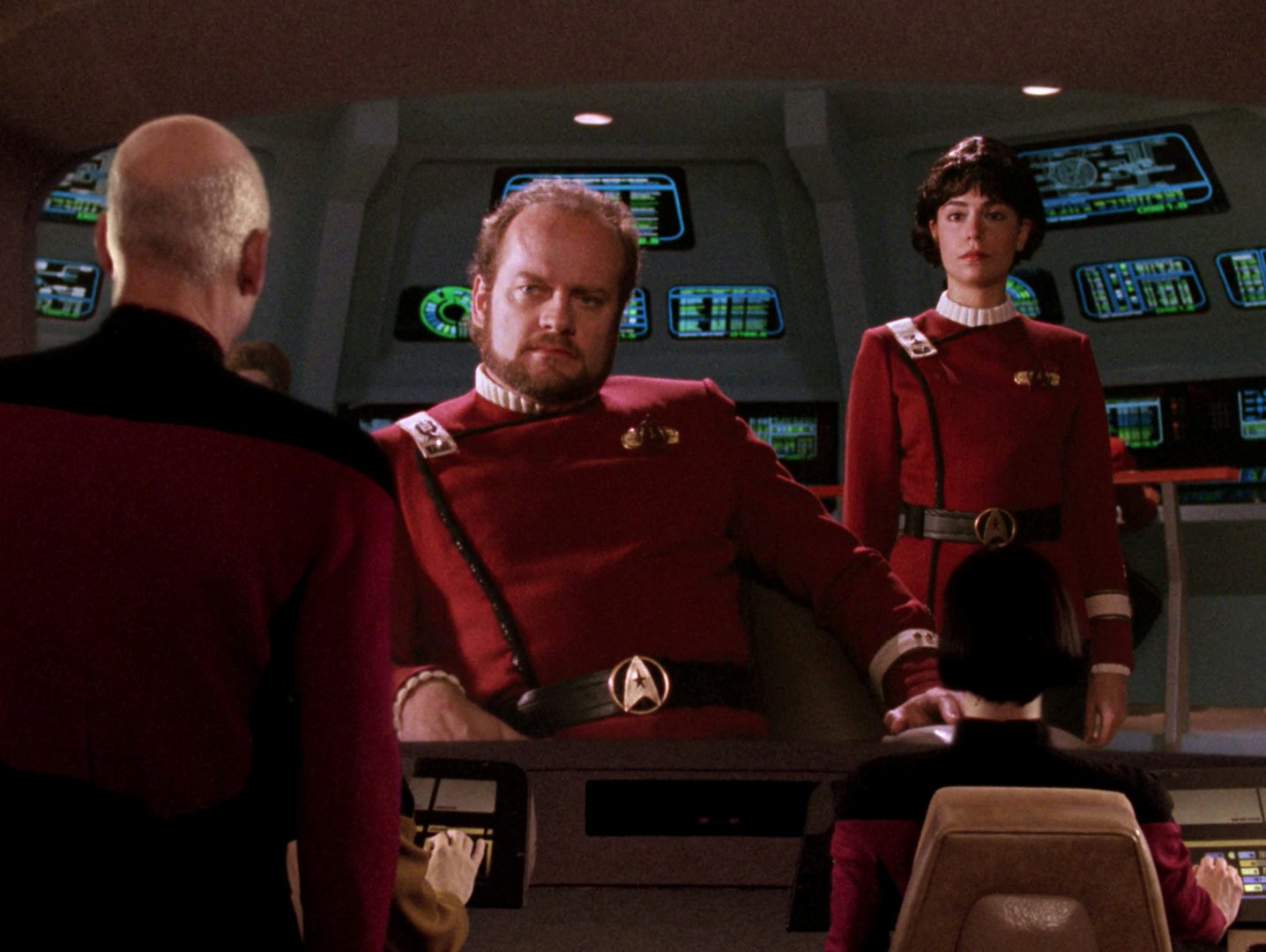
Let’s rock and roll!
One of the coolest scenes from Star Trek: First Contact — aka the movie about humanity’s, well, first alien contact, with our friends the Vulcans — just got revisited and recreated in the Season 3 premiere of Star Trek: Lower Decks in a way that doubles down on one of the franchise’s older ideas about in-universe pop culture.
How much do the people of Earth in the 2380s, circa Lower Decks Season 3, know about the exact events of April 5, 2063? In other words, did the Enterprise-E’s time travel adventure in First Contact change the timeline or protect history? For Mike McMahan, the creator and showrunner of Lower Decks, the answer is: a little bit of both. Spoilers ahead.
In Star Trek: First Contact, the crew of the USS Enterprise-E traveled from the year 2373 back to 2063 to help the human inventor of warp drive — Zefram Cochrane (James Cromwell) — make his very first faster-than-light journey.
The classic 1996 movie makes it pretty clear that, when Troi (Marina Sirtis), Riker (Jonathan Frakes), and Geordi (LeVar Burton) help Cochrane rebuild and fly the Phoenix, they’re making first contact happen, thus preserving the timeline, and not trying to change it.
And yet, First Contact doesn’t suggest a predestination paradox per se. Various aspects of Zefram Cochrane’s personality in “real life” seem very different to the Enterprise crew than their recollection of Earth history.

And now, Lower Decks has completed the circle begun by First Contact. Turns out Starfleet, and the citizens of Earth, totally know more about Zefram Cochrane than they did prior to the time travel shenanigans of Picard and his crew. When Mariner (Tawny Newsome), Boimler (Jack Quaid), Tendi (Noël Wells), and Rutherford (Eugene Cordero) hit up “historical Bozeman,” the entire location reflects specific information that must have been picked up by the Enterprise crew.
“What did Geordi know about Zefram when he went back? He didn’t know everything.” Mike McMahan explains. “So, for me, once [the Enterprise crew] had come back, they had met the man. In the pursuit of truth, they would have had to put in a report. Their time travel wasn’t secret, right?”
In the Lower Decks Season 3 premiere, a holographic recreation of Zefram Cochrane guides tourists on a recreation of the first warp flight. James Cromwell returns as the voice of Zefram Cochrane, and we even get cuts from Jerry Goldsmith’s First Contact score, as well Steppenwolf’s “Magic Carpet Ride.”
Given that this reenactment includes the classic rock hit, it seems that Riker and La Forge’s report of the flight was super-detailed. Tendi even mentions the nearby bar which had a “one-song jukebox.” (That song was the Roy Orbison track “Ooby Dooby,” which Cochrane played for the Vulcans after their arrival on Earth.)

McMahan has obviously put a lot of thought into how the details of Cochrane’s flight might disseminate in a Star Trek future. “First off, they're not changing the timeline,” he points out. “They’re telling people in the future about it. Second off, they’ve got to warn people that the Borg can do that. And, honestly, I think celebrating the man and the thing he did would be more valuable than creating a mythological being, which is what Zefram Cochrane didn’t want to be.”
The addition of the First Contact plot in Lower Decks’ “Grounded” doubles down on one of Star Trek’s more intriguing worldbuilding themes. McMahan continues: “I think this is one of the things that Lower Decks does, and it’s the weirdest thing, but it totally makes sense: our characters probably watch as many holodeck ‘Star Trek shows’ as Riker does.”
McMahan is referencing something he’s said before, the notion that “people on Star Trek watch Star Trek,” which was established in the finale of Star Trek: Enterprise, when Riker experiences a holodeck version of the events of 2161, essentially, a retro-Starfleet adventure, from his point-of-view.
But this idea of mass media Starfleet stories existing in-universe was also a concept suggested by Trek creator Gene Roddenberry; in the framing of his novelization of The Motion Picture, we’re told that even in Kirk’s time popular retellings of Starfleet exploits exist for public consumption.
Lower Decks has gone whole hog on this notion, with various characters referencing the names of Star Trek episodes, while the entire plot of “I, Excretus,” in Season 2 firmly established that many famous Star Trek episodes have parallel holographic counterparts within the Star Trek universe.
Lower Decks Season 3 premiere twist-ending, explained
Lower Decks’ latest deep-cut references from the Star Trek canon doesn’t end with First Contact. In the denouement of “Grounded,” we’re treated to a quick montage narrated by Captain Freeman (Dawnn Lewis), which reveals an entirely different (and star-studded!) adventure was happening behind the scenes, while our lower deckers were trying to save the day.
We get to see a glimpse of Tuvok from Star Trek: Voyager, as well as Captain Morgan Bateson, a deep-cut one-off character — famously played by Fraiser actor Kelsey Grammer — from the fan-favorite TNG episode, “Cause and Effect.”

McMahan says that this moment, when the rug is pulled out from under both the lower deckers and the audience, is perfectly in keeping with the point of the series. Because the story of Lower Decks isn’t about the top-level Starfleet officers, it makes sense that many very cool adventures would be things they’d never know about until much later.
“The whole season was never going to be the hunt for Captain Freeman,” McMahan says. “We wanted to resolve that pretty quickly. I felt that the second part of a two-part episode is almost never as good as the first part. So, the things we see in that sequence are meant to be a pitch to the lower deckers themselves. Like, ‘wow that would have been amazing to see that episode!’ Because that’s how the lower deckers experience these events. The show has told what it is before.”
Star Trek: Lower Decks Season 3 airs new episodes on Thursdays on Paramount+








